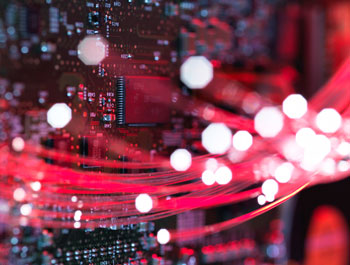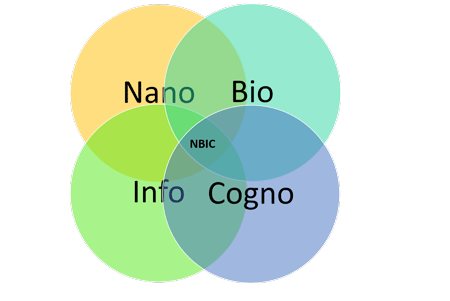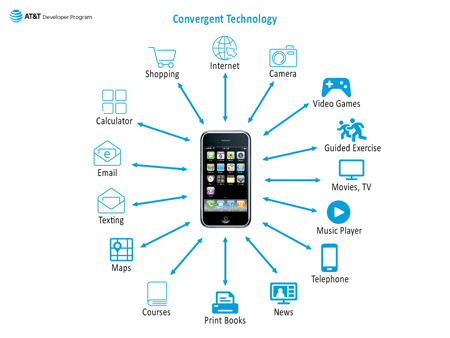The complete and modern guide to technology convergence

Technology innovation is not linear. There is not a line where one company develops something that leads to another company developing a more advanced version of something else, and so on. Looking at past technology innovation in hindsight is even challenging, especially within the last two decades because it feels like it is accelerating. Ray Kurzweil, in his book, The Singularity is Near, explains that technology is accelerating at an exponential pace. Now, even more than ever, technology is accelerating because of the intersection of all of the different disciplines. Technology convergence describes this phenomenon so you can try to wrap your head around what the future of technology will hold, and why it is not just taking over, but expanding the marketplace.
In this article, we discuss technology convergence: what it is, the different types, how it is regulated, and its (relative) history. We then cover different viewpoints about technology convergence, the benefits and challenges, and the possible future. Finally, we have our experts on technology convergence weigh-in with their opinions.
What is Technology Convergence?
A convergence is when two or more distinct things come together. Technology convergence is when different forms of technologies cohabitate in a single device, sharing resources and interacting, creating new technology and convenience. This simplistic definition is only the tip of the iceberg however, because technology convergence is technical and functional. An example of technology convergence is smartphones, which combine the functionality of a telephone, a camera, a music player, and a digital personal assistant (among other things) into one device. A tablet computer is another example of technology convergence. Developed especially for convergence, the tablet computer combines multiple devices into one device that you can carry anywhere. Technology convergence is integration and digitalization, according to “Policy initiative Dilemmas on Media Convergence: A Cross National Perspective,” by Siddhartha Menon. Both concepts of integration and digitalization are important concepts in the convergence of technology.
However, there is distinction between integrated and converged technology. Integrated solutions use an application program interface (API) or another type of interface to connect systems. An API is a set of rules that say how different software components should interact. In an integrated system there is separation between the multiple systems, bridged by a device acting as an intermediary. This is different from a converged solution, because this type of technology relies on the different systems being bridged or zippered in some way. The technologies can be converged at the physical level, such as at a sensor in the I/O board, or at the application level, such as a merged database. Converged solutions are considered more stable than integrated solutions because externally they appear to be one system, functionally converged.
In The Network Society, Jan Van Dijk discusses digitalization as technically superior and the reason why technology convergence is even possible. Digitalization is where all signals are chopped up into pieces of zeros and ones, according to Jan Van Dijk. Digitalization is a strategy of adopting, managing, and processing all that digitized data, which is more efficient than analog data and other data types of the past.
Technology convergence pushes alliances between once isolated industries such as broadcasting, computing, and electronics. Colin R. Blackman looks at technology convergence as a trend that affects the regulatory agencies as well. According to “Convergence between Telecommunications and Other Media: How Would Regulation Adapt?” article by Blackman, with the evolution of new hybridized technology, the regulating agencies that were also once separate will have to evolve new rules to cover everything appropriately. Lastly when discussing technology convergence, some academics say that it is not just these separate industries in Information and Communication Technology (ICT) coming together, but the full takeover of digital computers which will become almost impossible to regulate.
The Types of Convergence
Although the convergence of digital data started it all, you can categorize all many other types of convergence into high-level categories. These include technology, tools, and services, media, industry, and information technology. Further, convergent technology should not be confused with emergent technology.
Digital convergence is when you can have the same multimedia content available to view on different types of devices, because it is digitized. Digitized content is information organized into units called bits or bytes. These are in the form of binary numbers (1s and 0s), and when information is binary it can be intermingled, sent, published, and stored with the same efficiency. This is different from analog data of the past, which is degraded every time it is copied or transmitted. This digital convergence is making technological convergence possible.
The most well-known and understandable type of convergence is the smartphone itself. This is an excellent example of technology convergence. ICT, computer networks, and media come together in one platform that allows multi-functionality. Many devices were able to be left at home unused once more stable versions of the smartphone were released. The term “smartphone” was coined by the Ericsson Company in 1997 for one of their phones, the GS88. Ericsson’s R380 phone was marketed as the world’s first smartphone with an operating system (OS) called Symbian. Many experts contend that the first “real” smartphone was the first iPhone, and point to examples of how its design was incorporated by other companies after its release. However, the iPhone was released a good 10 years after the R380 and in that time there were plenty of models in that time period that offered much of the same functionality albeit in a less stylish form factor. Today, there are billions of smartphone users, and the device continues to replace more and more technologies, products, and services with the release of each iteration and application. For the future, only the limits of the hardware, and of course our human imagination, will impede the functions a smartphone can handle.
Another type of convergence is what some experts are calling the “Internet of Transport.” This is the transportation industry shifting to using digital technologies and being constantly connected to the network. This includes everything from automobiles designed to accommodate your smartphones and Internet activities to public transportation options that allow mobile payment options, real-time updates, and support Wi-Fi so there are no more coverage dead spots.
Media convergence is the joining together of different mass communication formats and the Internet. This is especially apparent in the creative media sector. For example, think about releasing a story to the public in a print book form. Media convergence is putting that book put onto your Kindle as another vehicle for content delivery, made into a movie, put on Audible, and even made into a video game for people to play with the story’s characters. This is not merely an adaptation from one form of media to another, such as toys being produced from films, but a deepening of your original content to make it more complex and accessible. Billboards and print media have pointed their viewers to the Internet to see details behind their content, but now we have even more content accessible via the Internet. Another example is in magazines. Glossy photos are chosen and laid out in the print medium that you can purchase (or leaf through) in the grocery store. However, many of the layouts also offer more pictures available from the photoshoot or to extend the story online.
Grover and Vaswani say that technology convergence is expanding services in what were once traditionally separate industries. The industries of information technology, telecommunication, consumer electronics, and entertainment (ITTCE) are coming together into one industry because digitized content is making them more similar, blurring the lines between them, and causing unprecedented cross-overs. For example, a product like Microsoft’s Xbox would have once been part of the information technology industry, but is now part of the entertainment industry. Another example is Sony’s Vaio. Once it would have been considered a consumer electronic. Now, it is part of the information technology industry.

The 3 C’s of technology refers to the convergence of computers, content, and communication. When people spoke about computer technology in the late 1990s, they meant a large room full of computers where people gathered to process their data. Now computing has evolved to separate but interconnected computers everywhere. These networks help with sharing the load of processing and do not require colocation of the users or the computer’s resources.
Information technology (IT) includes mostly physical devices such as computers, storage, and devices to network. It also includes the processes of electronic data, software, and its infrastructure. IT is crossing over in many directions now. Aside from the devices that can support many functions, IT is converging with operational technology (OT). Operational technology are systems that monitor processes and events. The devices in OT are charged with making adjustments in operations, such as in manufacturing or industrial environments. Historically, IT and OT were also separate processes, now, they are converged and improving thanks to the Internet of Things (IoT).
Nanotechnology, biotechnology, information technology, and cognitive science (NBIC) are diverse fields that are converging, described as “Converging technologies for improving human performance”. This phrase was coined by M.C. Roco and W.S. Bainbridge in their report of the same name. Their work describes these technologies as merging to improve things like social productivity, disaster response, communication and performance, aging deterioration, and evolutionary advancements. They refer to NBIC as cutting edge development for both the individual and society, at the nanoscale of cells and at the macro-level of culture. This new discipline describes the intersection of the four scientific areas as the cognitive scientists thinking it, the nanotechnology scientists building it, the biotechnology scientists implementing it, and the information technology professionals monitoring and controlling it. The “it” in this scenario describes futuristic scientific developments such as direct brain-to-brain communication, the evolution of our brain capabilities, and the ability to regulate our body functions far beyond their current capacities. Many of the advancements that will come out of the harmony of these sciences seem like science-fiction, but are really the result of decades of development in these fields.

Emerging technologies are different from converging technologies. Emerging technologies are those that we see as being able to substantially alter their environment. Emerging technology is a bit of a subjective term, because people may see different technologies in different ways. Some people may see the technology as threatening or not useful, and some may see it as the next big disruptor. To consider something as emerging technology it must be new, have fast growth, have the potential to make a big impact, have designs based on solid theories, and have its full use as uncertain or indistinct. It can be in any industry, or any converged industries, but they should be able to move beyond just an incremental increase in capability.
Not all convergent technology spawn products or data. Also coming out of convergence are services. Examples of these include:
- Video on demand: Think streaming services.
- Mobile-to-mobile: This has no need for fixed location capabilities.
- Location-based services: Being able to determine where the nearest ATM is located.
- Fixed-mobile convergence: Services that are irrespective of their location.
- Integrated products and bundles: These “super solutions” keep your services for multiple solutions with just one provider.
- IP Multimedia Subsystem: This integrated telecommunications network enables the use of Internet Protocols to communicate.
- Session Initiation Protocol (SIP): This is a call setup protocol that can be operated over the Internet.
- Internet Protocol Television (IPTV): The delivery of television over the Internet.
- Voice over IP (VoIP): Phone service over the Internet, made possible by SIP.
- Voice call continuity (VCC): This service determine how a voice call is delivered, enabling it to be delivered over both IP and CS networks.
- Digital video broadcasting: The standards developed for transmitting digital television.
Technology Convergence Regulatory Issues
Due to technology and marketplace changes, regulation and the agencies charged with regulating the individual industries have had to evolve as well. Without distinct functional differences between the infrastructure and services, the best way to license and regulate providers is unclear. Another convergence–this time of the regulators–has been suggested by experts. With the traditional distinctions between the various forms of media blurring, regulators may not be sure how stringent to make the rules yet, especially in light of the speed that technology evolves.
Computer products have not traditionally been regulated. However, both telecommunications and media have been significantly regulated. For example, broadcasting is subject to content regulations. Factors that regulators may need to consider in this convergence include competition between the converged companies, previous choices in regulation, how the environment is perceived, knowledge about the new technology, and how much power they can exert over the rules evolving. Many of the leading computer and telecommunications industry leaders have joined a consortium to work out some of the big regulatory issues by developing common standards. Although this benefits everyone, it primarily benefits the companies because it will decrease or negate any slowdowns that regulatory agencies could impose on them.
Lastly, one of the biggest issues in the creative media sector and regulation of digital data is the issue of intellectual property (IP), which are creations of the mind that may be considered property. This can be in music, film, TV, inventions, artwork, and literature. These are difficult things to lock down with content sharing being so easy and inexpensive thanks to digitized data. However, trademarking and copyrighting creative content can prevent copyright crimes. The Digital Millennium Copyright Act (DMCA) provides a mechanism for copyright holders to protect their content.
Regardless of what people think about technology convergence, or what rules we already have in place and need to get into place, we still need public service media, censorship, protection for IP, and to be protected from bullying, liable, illegal activities, and the loss of human rights. It is clear with all of the developments coming at lightning speed that policy and lawmakers have their work cut out for them.
The History of Technology Convergence
The history of convergence is difficult to trace. Media convergence has been coming on slowly for decades. Major publications have been experimenting with television and software applications since the 1970s and 1980s. Innovations are constantly being diffused into goods and many are becoming an integral part of products. However, with all of the extreme advancements in computing technology and its increased affordability in the 1990s, technology convergence and other types of convergence really accelerated. The widespread development of the Internet, the mobility and functionality of phones, and the eventual digitization of data were the crucial events that kicked convergence into high gear.

Many companies have become software companies in some fashion. For example, Amazon is considered by many to be a purveyor of physical goods. However, Amazon is really a software service that can sell just about anything online, with much of it being data-based, such as music, books, and movies. Marc Andreesen famously stated in 2011 that “Software is eating the world,” and that is nowhere more obvious than in our current big online retailers. With each new development, other companies subsume the technology leap, and push the envelope further and further. There are three big technologies that now underlie the next big crop of convergent breakthroughs, these include:
- Artificial Intelligence (AI): AI is when machines seem to be “intelligent.” What humans really mean by intelligence however, is the ability to perceive your environment and take actions that increase your chance of success in that environment. This includes using all of your knowledge, reasoning, problem solving skills, planning, learning, and ability to manipulate other people and objects. Other breakthroughs include new algorithms for image recognition and interpretation, and AI proliferating in educational curriculums. Deep learning is the term given in the machine learning field when these artificial neural networks, with many layers can understand and make learning representations of data. Deep learning enables us to know how machines can learn on their own, adapt, and get better. Deep learning is considered a breakthrough in converging technology in the field of AI and robotics.Robotics is a field that is considered related to AI, as robots require some of these skills for their success, especially the environmental perception, object manipulation, and possibly learning. The Turing test was created 50 years ago to determine if a machine was truly an intelligent system. If a system passes the Turing test it can be considered artificial intelligence. Many experts believe that all systems will pass this test within the next few years.
- Blockchain: Developed by the unknown Satoshi Nakamoto as a public ledger of the digital currency, Bitcoin, blockchain technology has evolved past its intended use. Blockchain is an immutable distributed database that grows as “blocks,” as sets of recordings are added to it. These recordings cannot be changed or deleted, and may be publically viewed, or seen by anyone with access to the network. This incorruptible, unhackable, global spreadsheet has the potential to revolutionize how transactions on the Internet are made and secured.
- The Internet of Things (IoT): IoT is when physical devices, also called connected devices or smart devices, have electronics implanted in them that give them the ability to link to the Internet. By connecting to the Internet, they can collect data, exchange data, make decisions, and control the device. All of these actions do not need people. IoT allows for anything that has an on/off switch to be connected to the Internet, allowing for an infinite number of opportunities. A simple example is connecting your coffeepot to the Internet. Once connected the pot can “see” when you set your alarm and have the coffee ready when you are woken. More complex examples include the cosmetics industry being able to “see” your clothing choice for the day and make suggestions for your makeup based on it, or your choice in groceries at one store informing other stores so that they can give you the best deal on accompanying products.
The Different Viewpoints on Converging Technology
Technologies converging can affect or even transform every sector of the economy. Through the research and development in this field, we will come to better understand ourselves and what it means to be human. There are many different viewpoints on converging technology. In the USA, the government (referring to it as NBIC) sees its apex as the mastery of the nano-scale world where life and non-life is integrated in the improvement of human performance. In Europe, there’s a movement to distance themselves from this American perspective. The Converging Technologies for the European Knowledge Society (CTEKS), a label from The European Commission sees the goals of converging technology in Europe as to solve societal problems such as obesity. Their take is that converging technology should benefit individuals and generate wealth, and are concerned that it may threaten culture, tradition, integrity, and political and economic stability.
ETC Group, known legally as Action Group on Erosion, Technology, and Concentration, list themselves as a group dedicated to addressing the issues that new technologies may bring on poor and vulnerable people. This environmentalist group calls converging technology BANG, which stands for bits, atoms, neurons, and genes. This group focuses on biodiversity, climate and geoengineering, corporate monopolies, sustainable development, synthetic biology, and the assessment of technology and focus on changing public policy and institutional change.
At SAP’s annual SAPPHIRE NOW event in Orlando in 2014, the overwhelming majority (90 percent) of business leaders felt that technology convergence will change the way that they do business, that it will drive innovation (59 percent), and relatively few (29 percent) thought that increasing revenue was the reasoning for working on converging devices. Several conferences have sprung up that focus on converging technology and the way that it is taking over business and research goals. Other one-time conferences have also emerged, such as in the automotive industry, but the annual ones include:
The Technology Convergence Conference (TCC): This event in Silicon Valley is for anyone to attend for learning and networking.
The International Conference for Convergence in Technology (IEEE): This event is also meant to increase learning and provide networking for technical professionals.
The Companies that Pioneered and Lead Converging Technology
Since successful innovative technologies were subsumed into many products, there are a host of companies that could be considered pioneers and leaders in convergent products. This is not to say that these companies go it alone. Many of them have developed or already have in place deep partnerships with other companies and sectors that help them in developing their technology, bringing it to market, or distributing it. Some of these companies just acquire other companies, whether small, niche startups with one good idea or technology, or larger operations with multiple initiatives. Examples of other media outlets that have crossed over and converged with other industries include AT&T, Warner Brothers, Time Warner, AOL, Facebook, Skype, BBC, and ITV. Here are some other key players:
Apple: The iPhone was a phone, a music player, and provided access to the Internet through a Safari web browser. After six months on the market Apple introduced the ability to add third-party applications to their iPhones, thus extending their capabilities well past those even originally intended. A big feature that hadn’t been introduced before was the multi-touch screen that had no need for a mouse, stylus, keyboard, or keys. This completely changed the industry, as all of the other companies offering smartphones prior to the iPhone release updated their product lines to support the touch screen. Further, the iPhone was and still is connected to the Apple Store, allowing the user to add new features in the form of apps and additional data content. Smartphones became miniature computers, which is truly how smartphones are defined today. To date, there have been 10 generations of the iPhone, and other convergent products and services include the iPad, the Apple watch, and iTunes.
Adobe: In the artistic arena, Adobe has developed many programs that converge technology and media. Their most well-known products are Photoshop and Acrobat. They also have their Adobe Creative Suite of products that focus on graphics for everything from print media to movies that take advantage of the digital convergence of data. Adobe is a developmental leader in what some experts consider the inevitable convergence of advertising, sales, and marketing technology.
Netflix: A leader in delivering digital content, constantly working on new delivery methods across platforms, Netflix is an excellent example of using media convergence. Founded in 1997, as a mail-order movie rental company. The movies could be rented on the Internet and delivered on the new DVD format. Within two years, they moved to a monthly subscription model. In 2007, the company moved to providing a streaming experience, and in 2012 they invested in creating original programming. Netflix is credited with bankrupting the Blockbuster movie rental company, and in the decline of DVD’s and cable television.
Amazon Prime: This is another example of a company being enabled by media convergence. Amazon Prime started as a subscription service for “free” 2-day shipping on all of their goods. Amazon Prime Video started streaming content in 2011, including movies and television episodes. The company also started offering e-books, photo storage, and streaming music, and got into original programming. Lastly, Amazon introduced its own line of household products and are more recently experimenting with food delivery options and smart convenience stores. Amazon’s virtual assistant in AI is called Alexa.
IBM: One of the largest information technology companies in the world, IBM (International Business Machines) offers hardware, software, and services. IBM is an example of network convergence, combining voice, video networks, and data networks. They also introduced what they call cognitive computing in 2011. Stephen Gold, who was the CMO, VP of Business Development, and expert on artificial intelligence, said that, “Cognitive computing marks the arrival of a new era in computing.” The cognitive computing was done through a series of algorithms and APIs called Watson, which is rooted in natural language processing, and uses the different language analysis algorithms to find answers to questions. Once the system has some potential answers, it checks them against a database for the most likely correct solution to a question. Watson gained media attention in 2011 by winning on the popular television game show Jeopardy against longtime Jeopardy champions. Since its win on Jeopardy, the Watson team expanded into healthcare with patient diagnostics and in finance by recommending new products to clients. In 2014, IBM introduced the Watson IoT platform, touting the converged technology as IoT that “thinks.”
Microsoft: Best known for its Office and Windows product lines, Microsoft has had its collective hand in almost all of the convergent technologies discussed here, including software and hardware. They have smartphones, game consoles, tablets, search engines, and their virtual assistant, Cortana. The company also makes apps for what once their fiercest competitor Apple, and perform research for speech recognition and AI.
Google: Google is considered the commercial leader of Internet search, maps, web browsing, curating information, open-source software, advertising, and the mobile platform. Although their core business is the search engine, Google developed the Android OS that competes with Apple’s iOS, and converges with telecommunications in their Google TV. Further, Google has tried its hand at every other major offering that Microsoft, Amazon, and Apple have. Lastly, Google is involved in AI with their virtual assistant, Google Now, and converges with the automotive industry through its work with self-driving cars.
The Benefits and Challenges of Convergent Technology
The benefits of convergent technology may be obvious. Everyone seems to approve when innovation makes our lives easier and saves lives, and when new technology allows us to do more with less. The benefits of technology convergence include:
- Time-saving and cost-saving devices
- Improving human performance
- Allows and encourages new ways to communicate
- In media, the audience can become more active than passive
- Encourages new product acceptance, as some of the functions are already well-known
- Less siloed information with digital data
- A single piece of technology simply does more
- One set of infrastructure is cheaper to operate
- Different price points can be addressed with essentially the same technology
- Watching media on a wide range of devices
- In certain fields like film production, what was once all professional-level equipment is now in the hands of everyone
However, we would be horribly naive if we decided that all technology convergence was good. Along with the good and innovations come some drawbacks. These include the following:
- Some converged devices are less reliable than the devices that perform a single task; they have lower quality
- With each added capability, the original device function is decreased
- Potential data security issues arise
- Possible waste of investments in separate technologies that was already made
- Increased expense in the combination of services and products and the need for a faster network
- Unknown regulatory issues
- Antitrust issues
What Is the Future of Converging Technology?
If we could look into a crystal ball and see what the future of converging technology would bring us, would we want it to look like what we imagined as children? Even though episodes of The Jetsons seem to already have come true (except for everyone having a flying car), what would we be able to conceptualize in the near and far future? Microsoft puts out its vision of the future every few years, and it often feels a bit like science fiction, but the report also serve to remind us that technological innovation is moving at a breakneck pace. Some of the future directions that experts have predicted include:
- The mixing of professional and personal content as a part of everyone’s lives. Sorry Dad, your slideshows with you personally narrating that trip to the Grand Canyon are truly a thing of the past.
- All next-generation AI systems will beat the Turing test.
- Normal computing will be truly global, incorporating all five senses.
- The application to major world problems such as terrorism, famine, and climate change.
- Using health data that is genetic, social, and individual to redefine the medical practice.
- AI is everywhere.
Our Experts in Converging Technology
We asked some experts in the converging technology field for their opinion on the current landscape, any issues that they see, what they feel the future holds, and their advice for other professionals. The following are their answers:

According to Maggie Kosal, Professor in the Sam Nunn School of International Affairs at Georgia Institute of Technology, “I have over 15 years as an experimentalist, technology developer, strategist, policy developer and implementer, and academic scholar in the field of Technology Convergence. My strategic direction has been to bring technology convergence into the Federal Biodefense and C-Weapons of Mass Destruction programs with the goal of generating revolutionary disruptive capabilities for the military.
“The converging technology landscape is hugely varied. There are places where it is thriving; different sectors have taken off –especially in the field of biotechnology we are seeing the biggest strides and intersections. These are happening at the science and application level at the intersection of biotechnology and informatics, biotechnology and cellular telephony, biotechnology and genomics, data analytics, nano-enabled devices and delivery systems. I am concerned about certain factors of American society. These include the death of expertise and the erosion of the value of expert knowledge. Everyone can Google something and think that they are experts. They get just enough knowledge to get them in trouble. Additionally, we have a lack of new, young professionals being able to enter the federal workforce because of hiring freezes and budget austerity. This is a long-term problem. With the aging of the federal workforce, we are unable to hire and keep new young folks with new skills and areas of knowledge. We need these professionals to eventually become strategic leaders. It is comparatively easier for them to get jobs in laboratories, and needed, but we need some of them to come out of the lab and lead.
“The future is converging technologies. If one does not recognize that they risk becoming an artifact of history. You don’t need in-depth knowledge in all fields, but you need to be able to speak to multiple fields with expertise. I would advise newly minted Ph.D.’s to do something different from what others are doing, to push the boundaries. For undergrads, I would not advise this because they have too little depth at just this level. For people who have been in their field for ten years or so I would say that the critical piece is not shifting focus to a new technology area or field, but doing the hard work of understanding the environment. This is the organization, structure, politics, culture, history, and economics. Don’t dismiss the soft sciences where you can learn about behavior, motivation, and psychology. Understand this environment that you are trying to drive change in. Your goal should be to get to the next level to get people to use the technology, and for it to become disruptive.”

According to Trey Gordner, CEO of Koios, “I am a software entrepreneur with experience in libraries and advertising technology. The company I founded helps libraries to appear in local Google search results. Not too long ago, the library had a monopoly on research. Now most amateur research starts on Google and ends in the references section of Wikipedia. As a result, there are many areas of convergence between libraries and search engines: their systems for organizing content, their methods for discovery, and their goal of accurate, timely information.
“Convergences are the best places to find new opportunities. I predict that we’ll see many more inventive cross-applications of new technologies, especially in startups. Startups want to be the first to jump the gap between two converging technologies. For example, the mash-up of retail and the Internet created ecommerce in general, but also a single big winner: Amazon. Machine learning is the next big opportunity. Expect to see thousands of little companies building niche predictive analytics applications.
“My advice is to take knowledge from one field and apply it creatively to another. In our case, we took our knowledge of digital marketing and advertising to a group that had historically never needed it: libraries. These public educational institutions are under pressure to prove their value as local budgets tighten and many believe (incorrectly) that it’s all on Google anyway. Libraries are now recognizing that online marketing can grow their user base and provide clear metrics that demonstrate ROI. When they do, we’ve positioned ourselves as the experts on the subject.”

According to COL T. Christopher Petty, U.S. Army “I have recently completed research for the U.S. Army on leveraging converging technologies that create a disruptive innovation in military capability. The world is on the cusp of a technological leap. The issue preventing the full capability of emerging technologies is within nanotechnology, specifically nano-manufacturing. This is getting molecules to self-replicate into nano-machines needed to construct all future technologies. Self-replication is the critical step required to take nanotechnology from government and university labs to the private industry to achieve the potential of emerging capabilities. Nanotechnology and specifically nano-manufacturing are the foundational innovation needed for the technology breakthroughs in fields such as AI, robotics, IoT, autonomous vehicles, 3D printing, biotechnology, materials science, energy storage, and quantum computing.
“We currently are seeing the benefits of nanotechnology as it allows the convergence of technologies in our cell phones, computing power, medical science, and even in the clothes we wear. NASA has developed a 3D printer capable of printing metal components for rockets and missiles. The issue is these emerging capabilities are either one of a kind or too expensive and complicated to be utilized in mass production or for a consumer to have on their desk in an office. Within ten years, breakthroughs in nano-manufacturing will reduce production cost and bring unimaginable technologies to our everyday lives.
“My advice to other professionals in this industry is to invest in nano-manufacturing and work hard to pull these technologies across the manufacturing gap from university and government laboratories into private industry to be produced. Eighty percent of all developed emerging technologies will never leave these labs, and this inhibits converging technology development.”

Michael Shearer, Director, Marketing Operations at SelectHub, says that Marketing Automation and CRM software are converging to spawn new technologies, specifically Customer Data Platforms (CDPs). These converging technologies caused the creation of these single unified databases that feed back into marketing automation/CRM systems. CDP expert, David Raab, expounds on the topic on ChiefMarTec as well, saying that CDPs solve the problem of the need for unified, accessible customer data. At some point all of these technologies (MA, CRM, CDP) will combine into a single platform. Watch for big company like Salesforce to acquire one of the successful CDP companies soon.
How do you think technology convergence will change the way we do things in the future? Leave a comment and let us know.
Explore How Technologies Converge at SHAPE
AT&T SHAPE is an immersive event that explores the convergence of technology and entertainment. Be inspired by luminary speakers, interactive demos, and hands-on creation activities. Listen to Gerd Leonhard (Futurist, Humanist, Author of ‘Technology vs. Humanity’ and CEO of The Futures Agency) discuss the challenge of digital transformation and the redefinition of human-machine relationships in the session titled The Network Revolution: Fueling the Next Generation of Entertainment Experiences.
SHAPE is happening July 14-15, 2017 in Los Angeles, California, at Warner Bros. Studios.
* The views expressed in this presentation do not necessarily reflect the views of AT&T.
